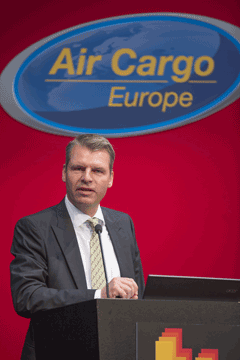
If
you think remembering who won airline of the year at that awards banquet
at Air Cargo Europe is tough to remember, try remembering a single detail
from even one discussion session at Air Cargo Europe 2013.
Yes, we are speaking 2013, but honestly,
unless you were there, you probably missed it.
As far as we can tell almost nobody covered
this content post-conference, unless you count those endless pages of
typed comments or transcripts that are made available on the show website
… if you can find them.
So we began to wonder: why keep setting
up panel discussions about the same topics at these trade shows only
to see most of the air cargo business ignore the talk, whilst another
batch of keynotes and panel discussions are set up two years later that
will end up in the same ignored place?
It sounds to us like many in air cargo
who labor to bridge understanding and educate best practices are involved
in a dead heat on a merry-go-round.
But in a “past is prologue”
move, FlyingTypers looks back two years and tries to connect
some of what we heard this time in Munich.
ACE 2013
Talking Points
 To recap on ACE 2013 and the key messages from that conference:
To recap on ACE 2013 and the key messages from that conference:
Dr. Andreas Otto, member of the Executive
Board Product and Sales, Lufthansa Cargo AG, who today serves as CCO
of Austrian Airlines, delivered an address to ACE.
Dr. Otto said he felt the opportunity
for digitization is a real chance for our industry.
However, the results are disappointing.
The industry produced 22.4 million air waybills in 2012; of these, eight
million were potential candidates for e-freight, but in reality 0.2
percent were flown as e-freight shipments.
Dr. Otto then in 2013 mapped the progress
of e-ticket:
The first e-ticket in 1994, 19 percent
penetration in 2004, 100 percent penetration in 2008, a total of 14
years from start to finish.
Compare that with e-freight: first e-freight
shipment in 2009, 0.1 percent in 2013, target 100 percent in 2015.
Moving forward, Dr. Otto insisted that
the industry must embrace this way of doing business and not ask ‘what’s
in it for me?’
Finally Dr. Otto outlined the e-strategy
for Lufthansa, building the business on a series of e-channels including
e-offering, e-freight, e-pieces, e-spots, e-boarding, e-customs, e-tracking,
and e-disputes, ending with the statement, “In 2020 I will be
digitally networked with all participants in the logistics chain.”
Another speaker, Prof. Dr. J. Rod Franklin,
P.E., managing director, Executive Education Adjunct Professor of Logistics,
The Kühne Logistics University opened a panel at Air Cargo Europe
in 2013 by suggesting the following areas could be ripe for innovation:
1.
Systems: suffering from a lack of integration;
outdated technology and designs; address yesterday’s issues and
are inappropriate.
2.
Processes: air cargo processes have not
fully adopted modern lean approaches. They lack customer focus in design.
3.
People: they are not incentivised to innovate.
Many are trained to be operational and not trained in creative thinking.
4.
Technology: air transport companies are
under pressure but have not upgraded their technologies, i.e. ageing
and outdated equipment.
5.
Infrastructure: airports are optimized
for passenger handling and not for cargo handling.
The panel’s reaction to the above
statements came in the form of the following ideas:
1.
More focus needs to be put on the
value that air cargo brings to the communities. IATA’s current
education campaign is a step in the right direction.
2.
Look at what
other industries are doing. Change the mind-sets of our people to embrace
technologies.
3.
Small innovations can really make a difference.
Two examples:
a.
The local replacement of handheld terminals for barcode reading. Large,
cumbersome, expensive hand-held devices with a battery life of six hours
that required constant changing and recharging were replaced with a
small application on a smart phone.
b. People would occasionally miss their train because of the queues
at the automatic ticket dispenser. The company developed a small application
that resided on a smart phone that allowed people to buy tickets using
their credit card, which removed the need to queue.
4.
Don’t be bound by the corporation.
Look at innovative solutions that can be done locally and cheaply. More
balanced risk taking. Local business cases for local implementations,
small entrepreneurial companies can assist.
5.
The industry has shown it can move quickly,
but only if it needs to. Such had been the case with the implementation
of AMS in the U.S. and ICS in Europe. However, this had been seen to
be reactive and not proactive.
Another 2013 ACE panel asked the question: What can air cargo learn
from other sectors, within or beyond the logistics/supply chain sector?
The panel felt we could certainly learn from our passenger and
travel colleagues.
For instance, their model for electronic ticketing guarantees 100 percent
penetration and very few data quality issues, as the ticketing data
is validated by the airline before the ticket is issued, unlike the
current e-AWB process.
The panel also felt that air cargo industry lacks transparency when
compared to other industries.
Shippers, in particular, want to see more done by the airlines and forwarders
and a far more proactive approach.
Some other topics of conversation included:
Q. Is air cargo preparing for the
last generation of messaging requirements, or the next?
A. The
panel felt that the content and quality of the message is actually more
important than the format, although it would be good to see convergence
on one standard. i.e. XML, for all modes of transport including air.
Since single window providers have also embraced XML. members of the
panel felt this to be the right move with some technology providing
already supporting XML standards.
Migration, however, may take some time, and maintaining two standards
may be required after IATA withdrew support for Cargo-IMP. Finally the
panel felt that e-business should really be the norm and rather than
look for returns on investment, the message is to get with the e-program
or risk being obsolete.
Q. Should air cargo companies leave
it to IATA and Cargo 2000 to dictate the terms and lead the way in terms
of messaging, or should technology companies be taking the lead?
A. The
2013 panel felt it should not be left to IATA and Cargo 2000 to drive
messaging. IATA and C2K are there to provide standards, and technology
providers are responsible for adopting those standards. However, business
leaders must drive the implementation. One school of thought suggested
that C2K could perhaps promote the C2K Master Operating Plan to a wider
audience.
Q. What information will shippers
need to exchange in 5 years/10 years?
A. Shippers
still want to see far more transparency in terms of the information
that is shared with them and service providers should be investing in
these areas. For instance if a shipment is delayed or offloaded, the
shipper should be notified and the recovery plan shared. Furthermore
it is hoped that shippers will not need to exchange information in years
to come and that electronic documents will be stored on servers that
can be accessed via links. Some technology companies have implemented
similar systems already.
Q. Do the e-commerce, social networking,
and smartphone revolutions require a response from the air cargo sector,
and if so, what should that response be?
A. A
study commissioned by IATA predicts that by 2017 50 percent of passenger
bookings will be made using smartphones. It will be interesting to see
how many air cargo bookings will be made in 2017 using this medium.
With a growing number of smart phone users in the world with a short
attention span, the smartphone will become the medium for doing business.
Some airlines have recognized this and have already implemented track
and trace for smart phones. The air cargo industry cannot ignore this
trend.
2013 to 2015
If you are thinking that these panel discussions sound relevant, and
as if they could have taken place this year at Air Cargo Europe, you
will get no argument from us.
Again, we present these words as indication that it seems no matter
how much we say, when it comes to the IT and paperless movement in air
cargo we are still talking, and clearly having trouble finding our way.
But point for point, there is lots of food for thought and some good
ideas from 2013 that bear review and adoption, or at least should not
be lost in time.
As much of our conversations and thoughts led back to these same subjects
when we met in Munich this year, these thoughts and ideas from 2013
should join the takeaway mix from 2015.
Let’s all move forward, smarter, FlyingTypers says!
How Can Air Cargo Move Ahead?
 We asked one person, who was part of the 2013 panels and also operates
a big company with much at stake in IT, to comment.
We asked one person, who was part of the 2013 panels and also operates
a big company with much at stake in IT, to comment.
Patrick Murray is head of Dubai-based Calogi.
As we have often said, Patrick is about as smart and thoughtful as it
gets in the air cargo IT game.
Q. So what did or is Calogi doing
with this valuable feedback from 2013 ACE?
A. We
at Calogi have taken a fresh look at the way we do e-business, recognizing
that the key is to offer the forwarder a better solution. dnata cargo
has taken the responsibility to print the air waybill at the terminal.
"We took this decision to prevent many of the small forwarders
from having to invest in a heavy-duty printer.
"We make an online A4 copy of the air waybill available to both
the forwarder and the airline should either feel the need to view or
print the same.
"Furthermore, should the airline nominate the shipment as an e-AWB,
by sending the code ‘ECC’ in the FWB message to dnata, we
will suppress the air waybill print—very simple and very effective.
"The major challenge we have now is how do we change the electronic
data once it has been submitted to the airline. If a forwarder submits
an FWB with incorrect consignee details, how does he change the details?
"Since the Charges Correction Advice (CCA) deals mainly with the
weight and charges, perhaps we need to extend the scope of this document
to include other data elements.
"The second concept Calogi is currently embracing is the options
for self-service and reducing the need for a customer to visit the dnata
counters.
"This is very much a work in progress, but we are making headway.
"The key is to simplify the acceptance and delivery process and
then build the solution. More to follow on this…
"Third, we have heard calls for transparency of shipment status
and we fully agree.
"Focusing on customer needs is what we do best, and we plan to
give forwarders and airlines a window into our handling system.
"This allows them to view ‘real-time’ status of the
shipment and to make decisions based on the same.
"Once again, this is work in progress, and we will be sharing more
details as we move forward."
Dr. Alexis
& The Quote of ACE 2015
 Overall, can anyone question or doubt the statement of Lufthansa Cargo
Board Member, product & Sales, Alexis von Hoensbroech, as he delivered
the Keynote 2015 at ACE?
Overall, can anyone question or doubt the statement of Lufthansa Cargo
Board Member, product & Sales, Alexis von Hoensbroech, as he delivered
the Keynote 2015 at ACE?
Dr. Alexis said a lot of things, but one sentence rang bold and clear:
“While there are several initiatives today—including these
IT sessions at Air Cargo Europe—my take is that it is really time
for air cargo to move on into the new century and embrace a digital
solution.
“Put another way—if we don’t do it, then others will
do it for us!
Just after Alexis said those words, I remember it started to rain inside
the meeting hall.
My first thought was that the words with the water might be a wakeup
call arranged and coordinated to maximize effect, but as it turned out,
there was just a leak in the ceiling.
But I thought the combination drove the point home.
FlyingTypers believes the industry has been guilty of looking
inwards, focusing more on what we need to develop to run our business
rather than starting from the customer and looking at their needs.
This is really where the Alibaba and Amazon e-commerce sites have taken
the game to a much higher level, which brings us quite nicely to 2015
and the recent ACE conference.
Taking just one agenda item that stood out for us: ‘e-Commerce
in Airfreight: Possibilities and Priorities’
The introduction to that session was as follows :
How can airfreight take full advantage of the e-Commerce revolution?
Can it adapt its processes, services, and tracking to become a more
attractive partner for e-Commerce shippers? What changes would that
require and what would be the potential benefits, realistically? Might
big e-Commerce firms such as Amazon or Alibaba take matters into their
own hands? And how can airfreight use the lessons and potential of e-Commerce
to optimize its own processes, for example via integrated web applications
for quotations, booking, and tracking services?
Bernd Maresh, owner of Maresch GmbH, moderated the session with the
following participants:
Guillaume Drucy, head of Cargo e-Business Management, IATA; Frank Naeve,
program manager e-Cargo, Lufthansa Cargo; Tim Scharwath, executive vice
president Air Logistics, Kühne & Nagel; Tobias Seidler, Supply
Chain Services, Fraunhofer Institute; David Yokeum, president, WCA Ltd.
and Marcus Fromm, managing director, Accenture Freight & Logistics
practice.
Without wishing to take anything away from the panel, here is our take
on those questions:
Q. How can airfreight take full
advantage of the e-Commerce revolution?
FT. The
e-Commerce revolution is a paradigm shift. For an airline/freight forwarder,
the traditional customer changes to the e-Commerce provider such as
Amazon or Alibaba. A key element to be considered by IT providers is
that the e-commerce providers will not want to log into several systems
to do business with their suppliers. Those forwarders or airlines able
to integrate seamlessly with e-commerce systems will be the players
who will win the business.
Q. Can IT adapt its processes, services,
and tracking to become a more attractive partner for e-Commerce shippers?
FT. It
(the air cargo industry) must adapt its processes and must shield the
customer from the complexities of the air freight business. An e-Commerce
customer wants to make an order, pay by credit card or account, and
know that the shipment will be delivered on a certain date and time.
He will not care if it is shipped with an e-AWB or what the fuel and
security charges are. He doesn’t even need to track the goods;
that is an internal issue for the air cargo industry and needed to ensure
predictable delivery.
He will care, however, if the goods do not arrive on time.
Deliver as promised will be a key goal for a successful supplier.
Q. What changes would that require
and what would be the potential benefits, realistically?
FT. A
large part of this would be the ability for the forwarder to consolidate
shipments and provide door-to-door service at competitive rates. Take
the ordering of DVDs or books for instance. Transporting and clearing
these items through customs on an individual basis would be extremely
time consuming and costly. FT believes that integrators are packaging
these shipments into larger consignments and working with Customs authorities
to bulk clear these commodities.
The benefits are that it’s a great, fast flowing line of business.
Someone must be making money from the transportation, so why not the
traditional forwarders and airlines?
Q. Might big e-Commerce firms such
as Amazon or Alibaba take matters into their own hands?
FT. Undoubtedly,
and it’s probably just a question of time. How long before we
see mini-landing strips for larger drones at manufacturing and distribution
centers? Inventories can be kept very low. As soon as the drone is fully
laden, send it on its way.
Q. How can airfreight use the lessons
and potential of e-Commerce to optimize its own processes, for example
via integrated web applications for quotations, booking, and tracking
services?
FT. Integrated
web applications already exist.
In fact, for the last seven years, as Patrick Murray points out, Calogi
has allowed airlines to quote rates, allowed forwarders to make e-bookings,
and made online tracking available to customers; nothing really new
there.
“Our unique credit management system and air waybill release scheme
allows us to settle over $10M USD in airline and Ground Handling Agent
dues per month,” Mr. Murray said.
“The next real metamorphosis for Calogi and elsewhere would be
to act as the middleman between the e-commerce providers and the service
providers for booking, pricing, milestone tracking, and exception handling,”
he added.
Final Words
In the words of Leon C. Megginson, fellow of the Academy of Management
(1973), the North American Case Research Association (1990), and the
Southern Management Association (1995).
“It is not the strongest or
the most intelligent who will survive but those who can best manage
change.”
Geoffrey





